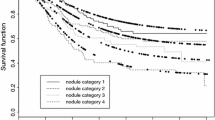Abstract
In this paper, we develop the steps of the expectation maximization algorithm (EM algorithm) for the determination of the maximum likelihood estimates (MLEs) of the parameters of the destructive exponentially weighted Poisson cure rate model in which the lifetimes are assumed to be Weibull. This model is more flexible than the promotion time cure rate model as it provides an interesting and realistic interpretation of the biological mechanism of the occurrence of an event of interest by including a destructive process of the initial number of causes in a competitive scenario. The standard errors of the MLEs are obtained by inverting the observed information matrix. An extensive Monte Carlo simulation study is carried out to evaluate the performance of the developed method of estimation. Finally, a known melanoma data are analyzed to illustrate the method of inference developed here. With these data, a comparison is also made with the scenario when the destructive mechanism is not included in the analysis.



Similar content being viewed by others
References
Balakrishnan N, Koutras MV, Milienos FS, Pal S (2016) Piecewise linear approximations for cure rate models and associated inferential issues. Methodol Comput Appl Probab (to appear). doi:10.1007/s11009-015-9477-0
Balakrishnan N, Pal S (2013a) Lognormal lifetimes and likelihood-based inference for flexible cure rate models based on COM-Poisson family. Comput Stat Data Anal 67:41–67
Balakrishnan N, Pal S (2013b) Expectation maximization-based likelihood inference for flexible cure rate models with Weibull lifetimes. Stat Methods Med Res (to appear). doi:10.1177/0962280213491641
Balakrishnan N, Pal S (2015) An EM algorithm for the estimation of parameters of a flexible cure rate model with generalized gamma lifetime and model discrimination using likelihood- and information-based methods. Comput Stat 30:151–189
Balakrishnan N, Peng Y (2006) Generalized gamma frailty model. Stat Med 25:2797–2816
Berkson J, Gage RP (1952) Survival curve for cancer patients following treatment. J Am Stat Assoc 47:501–515
Boag JW (1949) Maximum likelihood estimates of the proportion of patients cured by cancer therapy. J R Stat Soc Ser B 11:15–53
Chen M-H, Ibrahim JG, Sinha D (1999) A new Bayesian model for survival data with a surviving fraction. J Am Stat Assoc 94:909–919
Cooner F, Banerjee S, Carlin BP, Sinha D (2007) Flexible cure rate modeling under latent activation schemes. J Am Stat Assoc 102:560–572
Cox D, Oakes D (1984) Analysis of survival data. Chapman & Hall, London
Dempster AP, Laird NM, Rubin DB (1977) Maximum likelihood from incomplete data via the EM algorithm. J R Stat Soc Ser B 39:1–38
Farewell VT (1982) The use of mixture models for the analysis of survival data with long-term survivors. Biometrics 38:1041–1046
Hoggart CJ, Griffin JE (2001) A Bayesian partition model for customer attrition. In: George EI (ed) Bayesian methods with applications to science, policy, and official statistics (Selected Papers from ISBA 2000), Proceedings of the sixth world meeting of the international society for Bayesian analysis. International Society for Bayesian Analysis, Creta, pp 61–70
Ibrahim JG, Chen M-H, Sinha D (2001) Bayesian survival analysis. Springer, New York
Lange K (1995) A gradient algorithm locally equivalent to the EM algorithm. J R Stat Soc Ser B 57:425–437
Li CS, Taylor JMG, Sy JP (2001) Identifiability of cure models. Stat Probab Lett 54:389–395
Louis TA (1982) Finding the observed information matrix when using the EM algorithm. J R Stat Soc Ser B 44:226–233
Maller RA, Zhou X (1996) Survival analysis with long-term survivors. Wiley, New York
McLachlan GJ, Krishnan T (2008) The EM algorithm and extensions, 2nd edn. Wiley, Hoboken, NJ
Meeker WQ, Escobar LA (1998) Statistical methods for reliability data. Wiley, New York
Pal S, Balakrishnan N (2015) Likelihood inference based on EM algorithm for the destructive length-biased Poisson cure rate model with Weibull lifetime. Commun Stat Simul Comput (to appear). doi:10.1080/03610918.2015.1053918
Peng Y, Xu J (2012) An extended cure model and model selection. Lifetime Data Anal 18:215–233
R Core Team (2014) R: a language and environment for statistical computing. R Foundation for Statistical Computing, Vienna. http://www.R-project.org/
Rodrigues J, Cancho VG, de Castro M, Balakrishnan N (2012) A Bayesian destructive weighted Poisson cure rate model and an application to a cutaneous melanoma data. Stat Methods Med Res 21:585–597
Rodrigues J, de Castro M, Balakrishnan N, Cancho VG (2011) Destructive weighted Poisson cure rate models. Lifetime Data Anal 17:333–346
Rodrigues J, de Castro M, Cancho VG, Balakrishnan N (2009) COM-Poisson cure rate survival models and an application to a cutaneous melanoma data. J Stat Plan Inference 139:3605–3611
Scheike TH, Martinussen T (2006) Dynamic regression models for survival data. Springer, New York
Sy JP, Taylor JMG (2000) Estimation in a Cox proportional hazards cure model. Biometrics 56:227–236
Yakovlev AY, Tsodikov AD (1996) Stochastic models of tumor latency and their biostatistical applications. World Scientific Publishers, Singapore
Yakovlev AY, Tsodikov AD, Bass L (1993) A stochastic-model of hormesis. Mathematical Biosciences 116:197–219
Yin G, Ibrahim JG (2005) Cure rate models: a unified approach. Can J Stat 33:559–570
Acknowledgments
The second author expresses his thanks to the Natural Sciences and Engineering Research Council of Canada for funding this research through an individual discovery grant. The authors are also thankful to the editor and anonymous reviewers for their useful comments and suggestions on an earlier version of this manuscript which led to this improved one.
Author information
Authors and Affiliations
Corresponding author
Electronic supplementary material
Below is the link to the electronic supplementary material.
Appendix: Expressions useful in M-step
Appendix: Expressions useful in M-step
where
The above quantities are all defined for \(l,l^{\prime }=0,1,\ldots ,s,\,x_{i0}=1 \forall i=1,2,\ldots ,n,\) and \(k,k^{\prime }=1,2,\ldots ,s^\prime .\)
Rights and permissions
About this article
Cite this article
Pal, S., Balakrishnan, N. Likelihood inference for the destructive exponentially weighted Poisson cure rate model with Weibull lifetime and an application to melanoma data. Comput Stat 32, 429–449 (2017). https://doi.org/10.1007/s00180-016-0660-8
Received:
Accepted:
Published:
Issue Date:
DOI: https://doi.org/10.1007/s00180-016-0660-8




